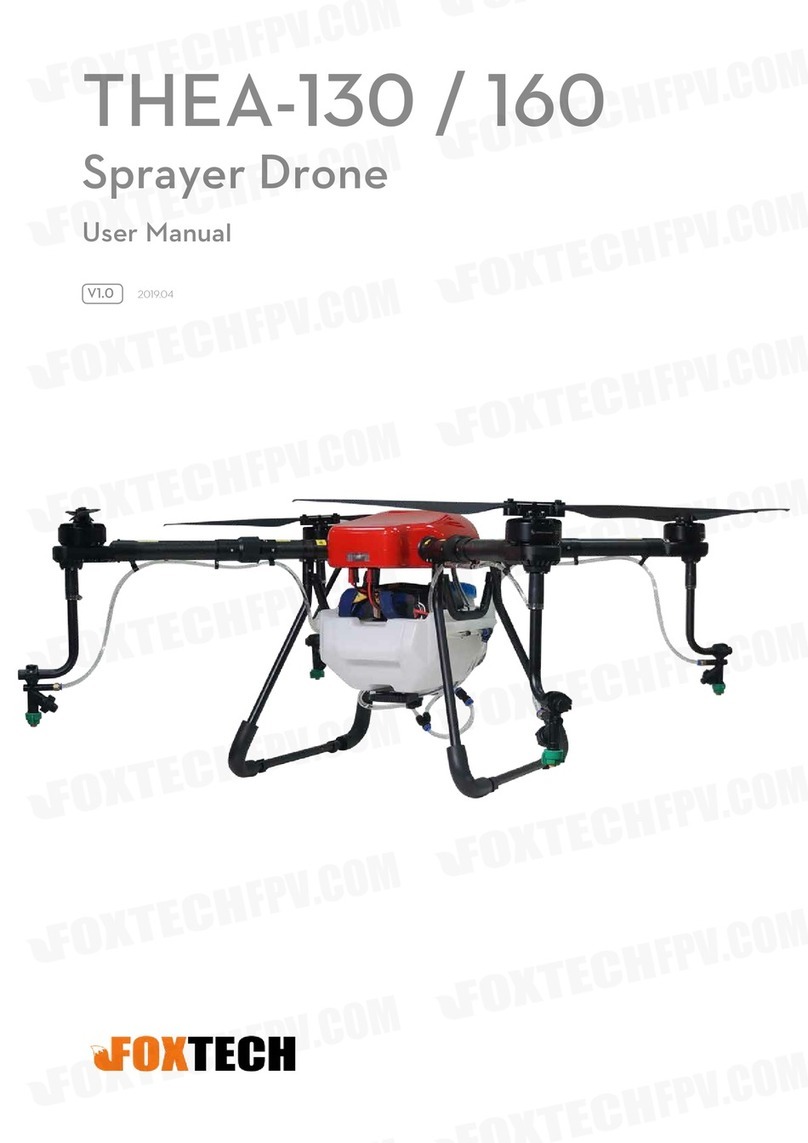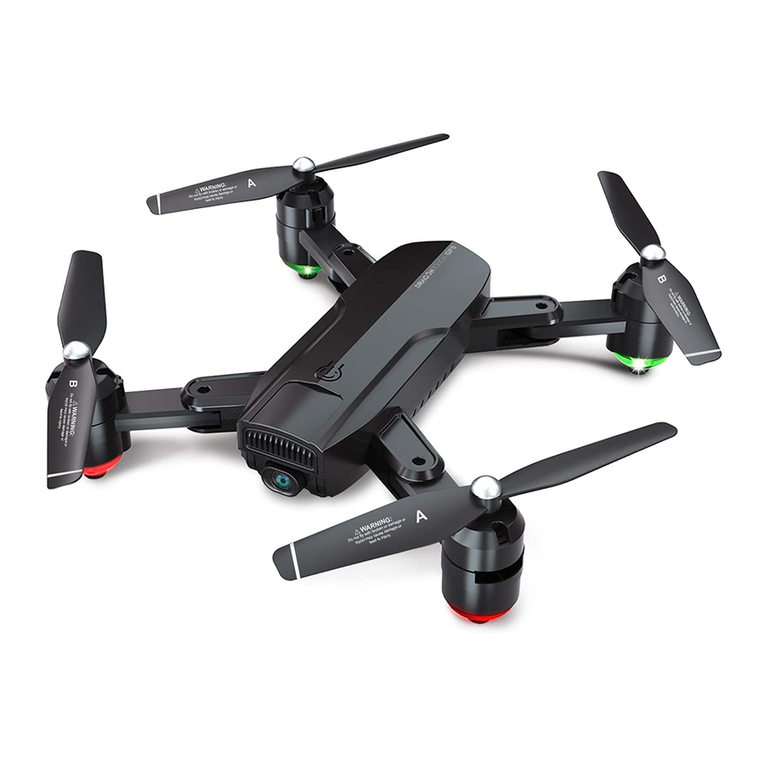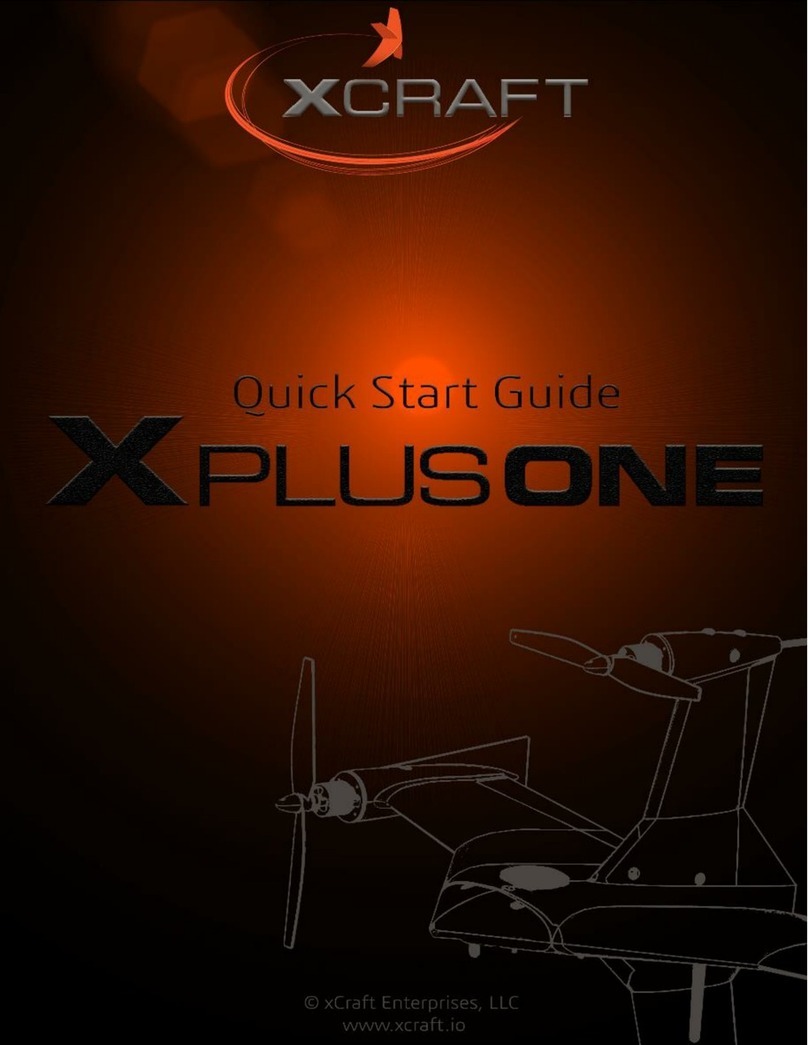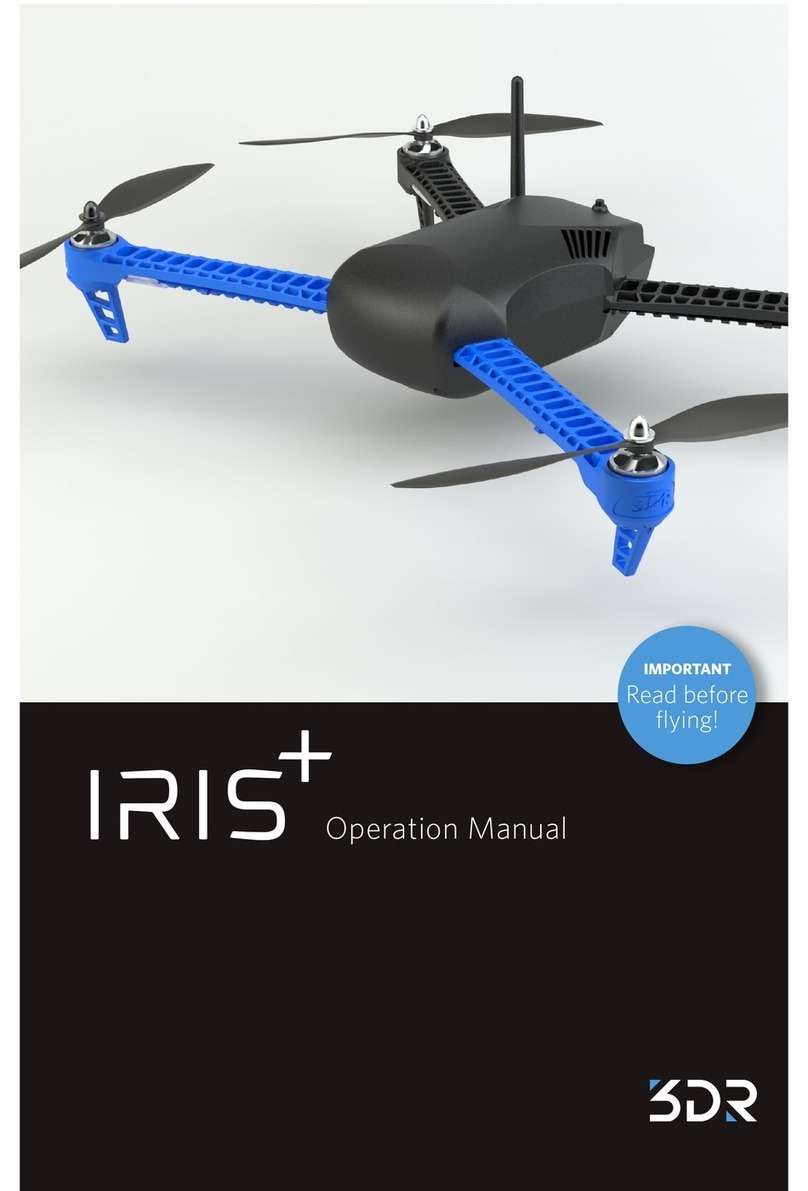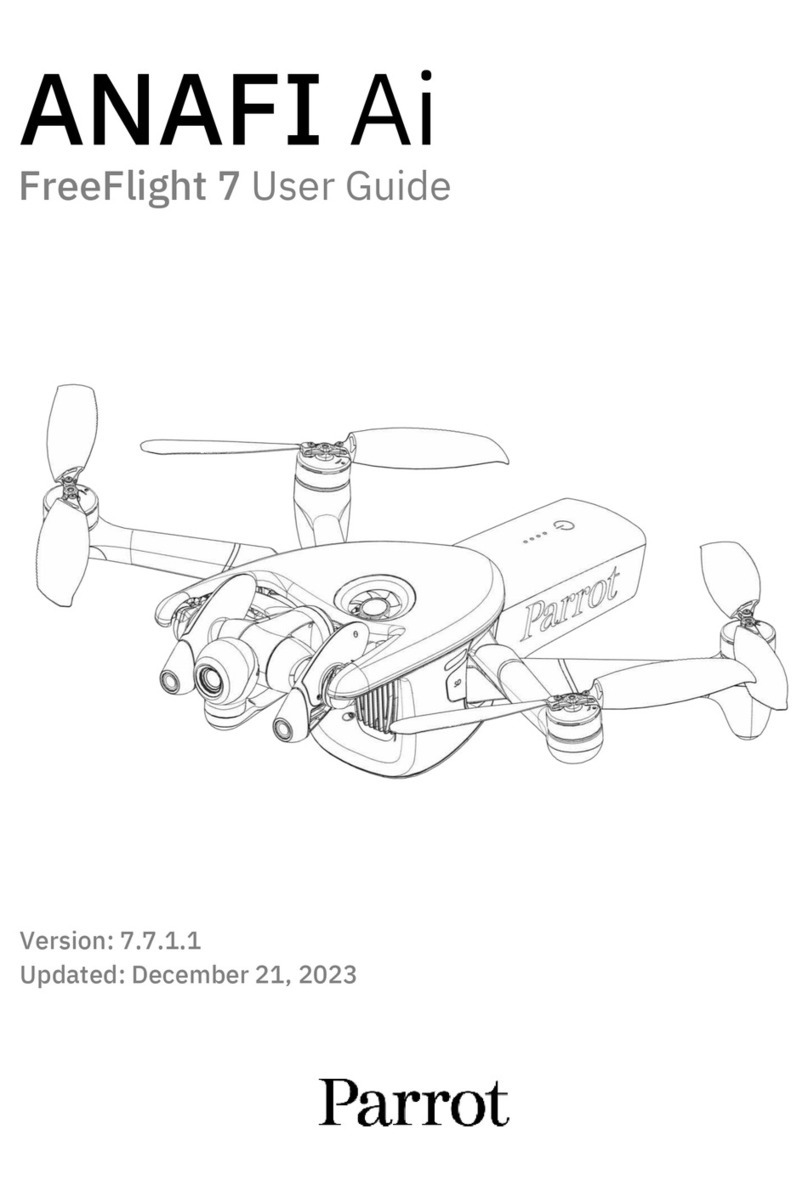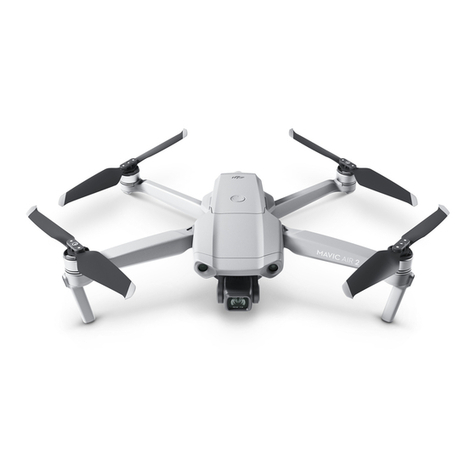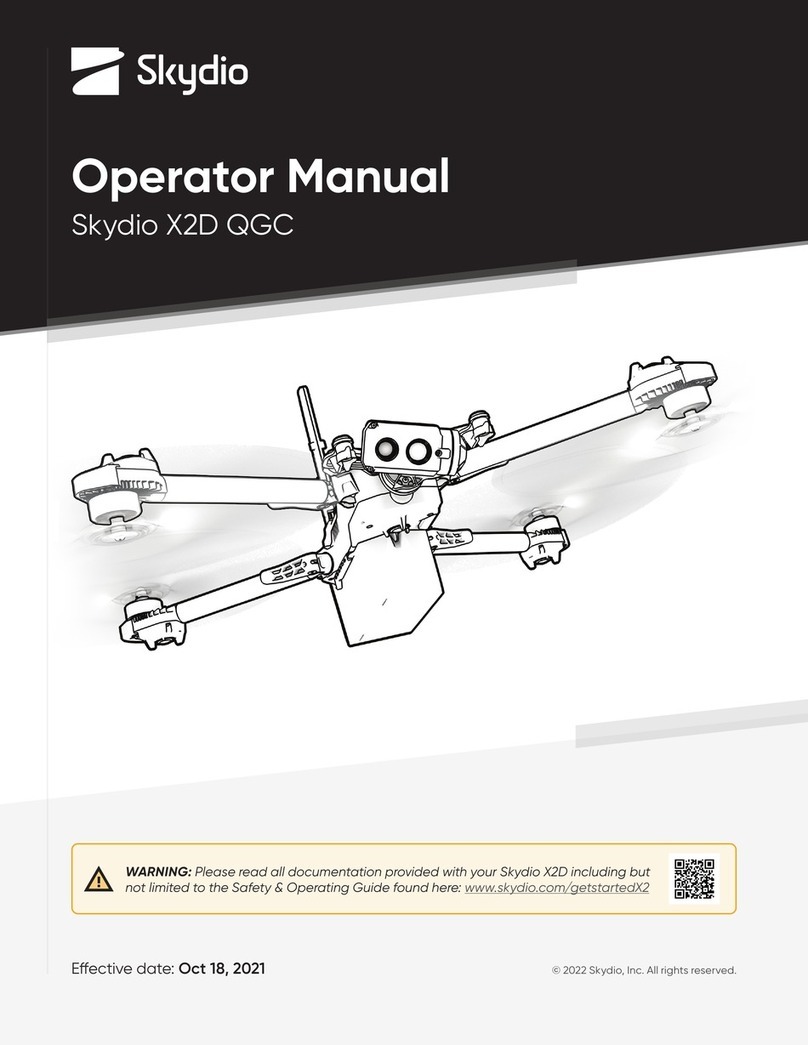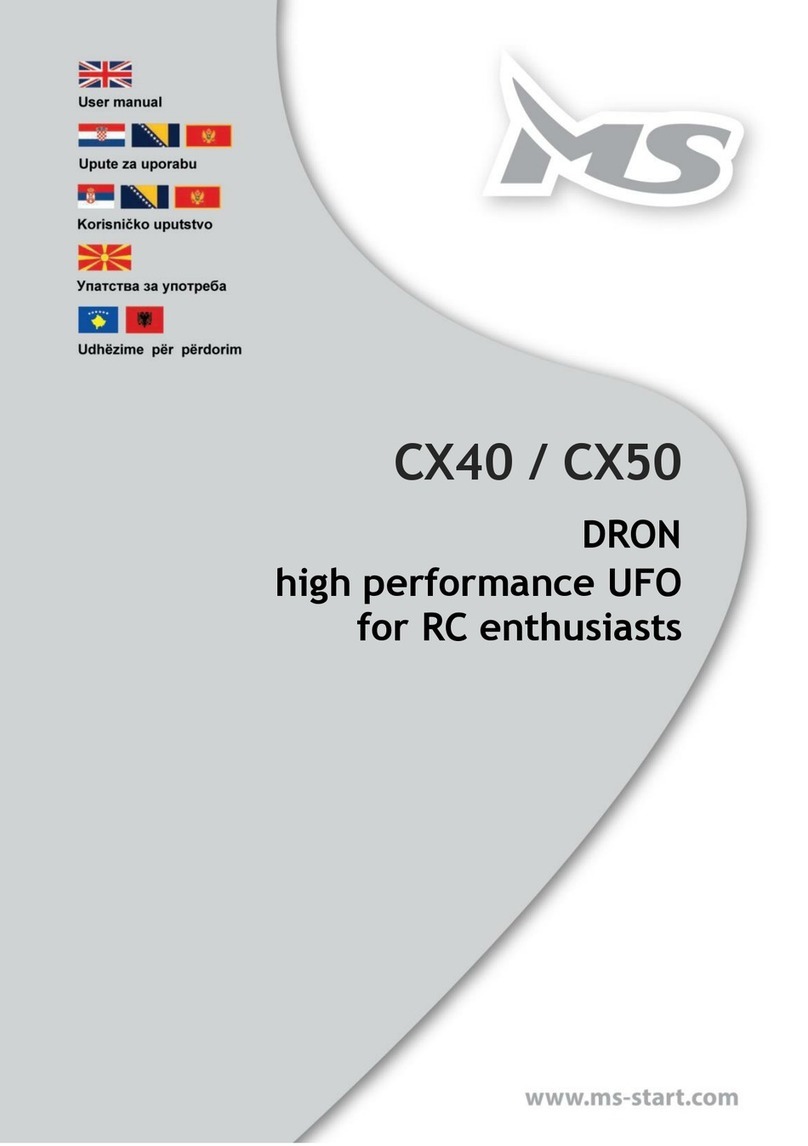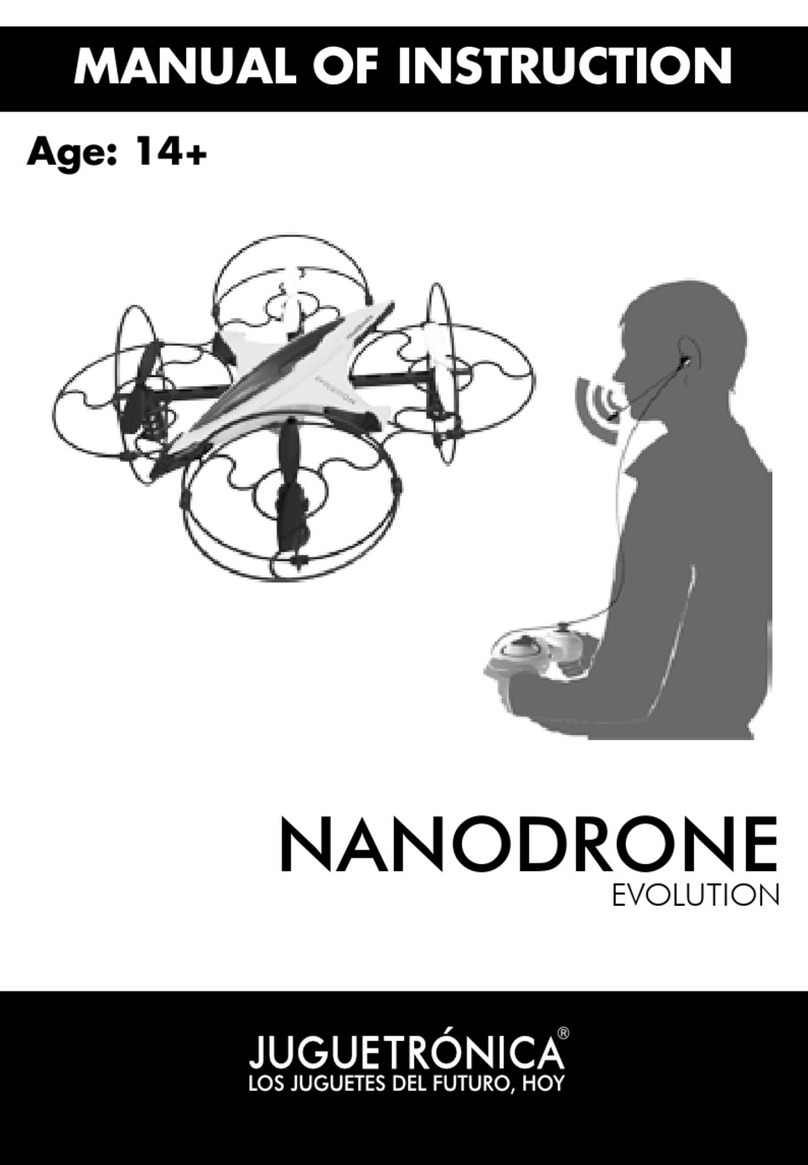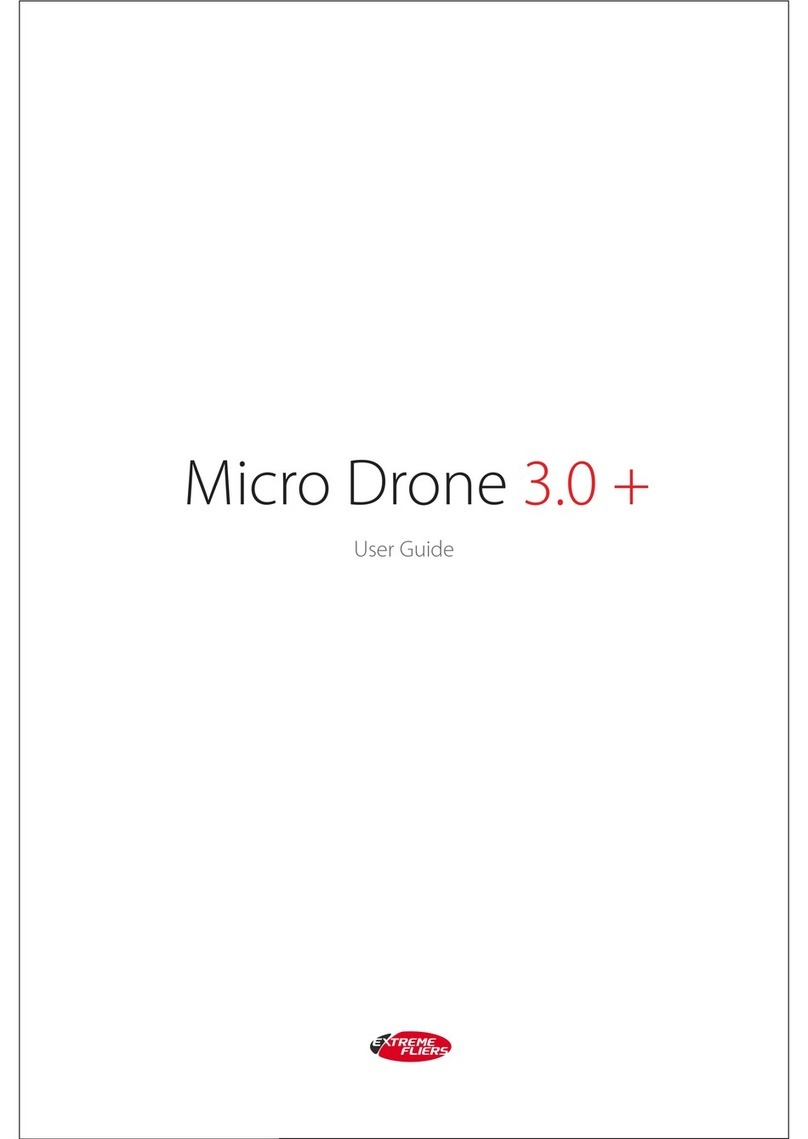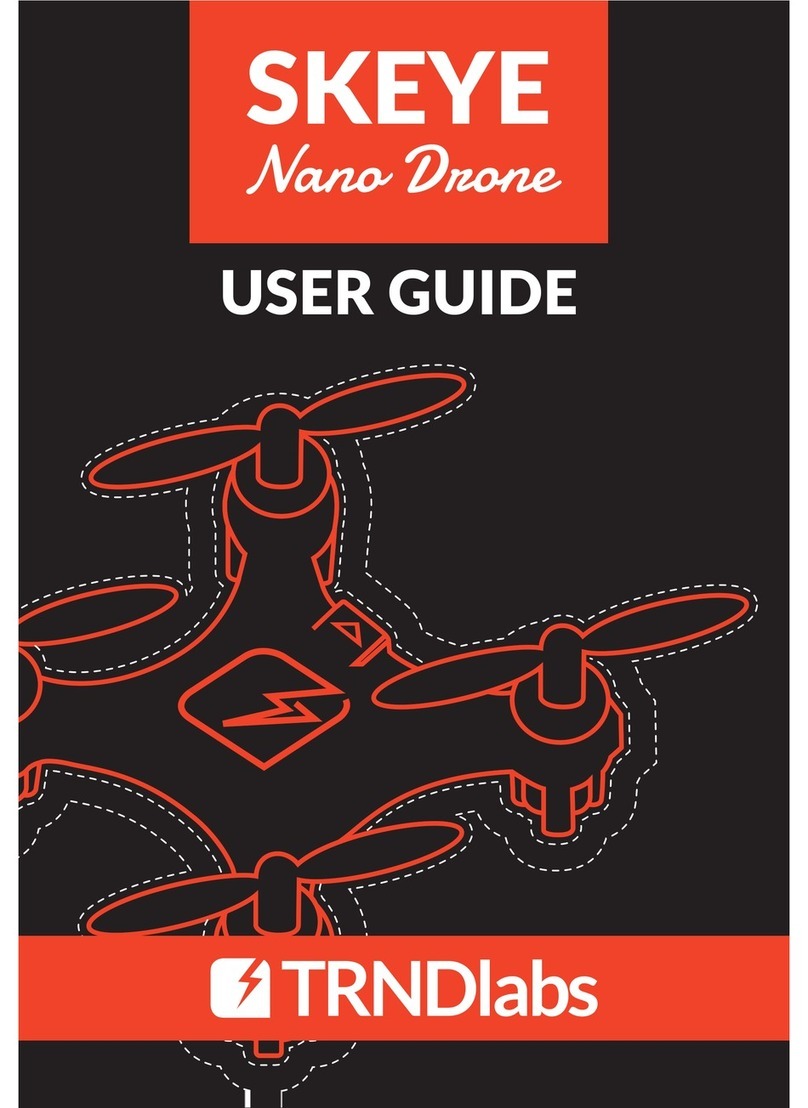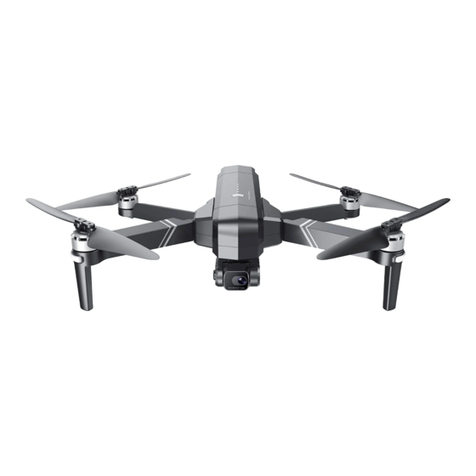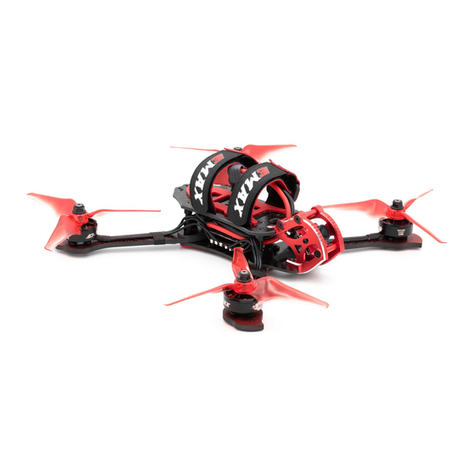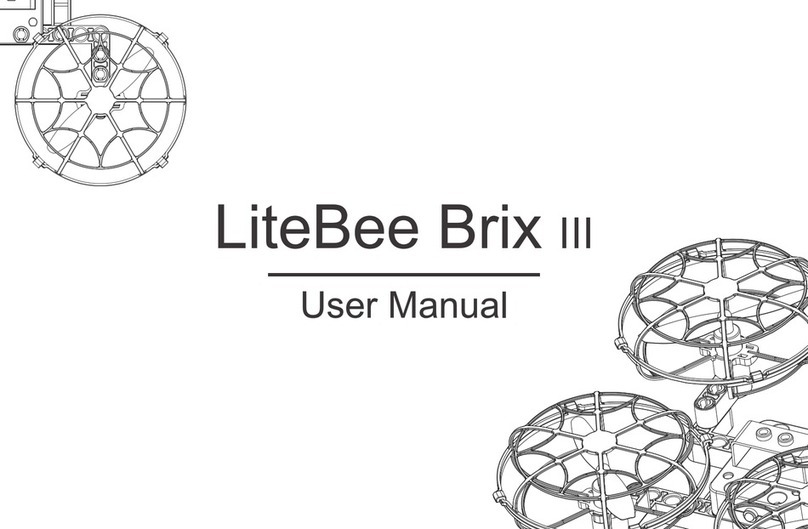Flyability ELIOS 2 User manual


ORIGINAL INSTRUCTIONS Page 3 of 26
Strictly confidential
EU DECLARATION OF CONFORMITY
We,
Flyability SA
EPFL INNOVATION PARK BLDG C, 1015 Lausanne, Switzerland
Tel: +41 21 311 55 00
declare under our sole responsibility that the product:
ELIOS 2
Model No. 3
Serial Number 3000000-4000000
to which this declaration relates is in conformity with the following standards or other normative
documents:
Safety
EN 62368-1:2014 + A11:2017
EN 62471:2008
EMC
EN 301 489-1 V2.2.0 (2017-03)
EN 301 489-17 V3.2.0 (2017-03)
Radio
EN 300 328 V2.1.1 (2016-11)
Health (RF Exposure)
EN 62311:2008
following the provisions of
-Radio Equipment Directive (RED) 2014/53/EU
-ROHS Directive: 2011/65/EU
-REACH Regulation: 2006/1907/EC
The Technical Construction File is maintained at:
Flyability SA
EPFL Innovation Park Bldg C, 1015 Lausanne, Switzerland
The authorized representative located within the Community is:
Dr. Adrien Briod
Chief Technology Officer
EPFL Innovation Park Bldg C, 1015 Lausanne, Switzerland
Date: April 29th, 2019


ORIGINAL INSTRUCTIONS Page 5 of 26
Strictly confidential
FCC COMPLIANCE NOTICE
This equipment must be installed and operated in accordance with provided instructions and the
antenna(s) used for this transmitter must be installed to provide a separation distance of at least 20
cm from all persons and must not be co-located or operating in conjunction with any other antenna
or transmitter. End-users and installers must be provided with antenna installation instructions and
transmitter operating conditions for satisfying RF exposure compliance.
This device complies with Part 15 of the FCC Rules. Operation is subject to the following two conditions:
This device may not cause harmful interference, and
This device must accept any interference received, including interference that may cause
undesired operation.
Any changes or modifications not expressly approved by the party responsible for compliance could
void the user’s authority to operate the equipment.
This equipment has been tested and found to comply with the limits for a Class B digital device,
pursuant to part 15 of the FCC Rules. These limits are designed to provide reasonable protection
against harmful interference in a residential installation. This equipment generates, uses and can
radiate radio frequency energy and, if not installed and used in accordance with the instructions, may
cause harmful interference to radio communications. However, there is no guarantee that
interference will not occur in a particular installation. If this equipment does cause harmful
interference to radio or television reception, which can be determined by turning the equipment off
and on, the user is encouraged to try to correct the interference by one or more of the following
measures:
Reorient or relocate the receiving antenna.
Increase the separation between the equipment and receiver.
Connect the equipment into an outlet on a circuit different from that to which the re-
ceiver is connected.
Consult the dealer or an experienced radio/TV technician for help.
FCC RF EXPOSURE INFORMATION
This equipment complies with FCC radiation exposure limits set forth for an uncontrolled
environment. In order to avoid the possibility of exceeding the FCC radio frequency exposure limits,
human proximity to the antenna shall not be less than 20cm during normal operation.
IC RSS WARNING
This device complies with Industry Canada license-exempt RSS standard(s). Operation is subject to the
following two conditions: (1) this device may not cause interference, and (2) this device must accept
any interference, including interference that may cause undesired operation of the device.
Le présent appareil est conforme aux CNR d'Industrie Canada applicables aux appareils radio exempts
de licence. L'exploitation est autorisée aux deux conditions suivantes : (1) l'appareil ne doit pas produire
de brouillage, et (2) l'utilisateur de l'appareil doit accepter tout brouillage radioélectrique subi, même
si le brouillage est susceptible d'en compromettre le fonctionnement.
IC RADIATION EXPOSURE STATEMENT
This equipment complies with IC RSS-102 radiation exposure limits set forth for an uncontrolled
environment. This equipment should be installed and operated with minimum distance 20cm
between the radiator & your body.

ORIGINAL INSTRUCTIONS Page 6 of 26
Strictly confidential
Ce matériel est conforme aux limites de dose d'exposition aux rayonnements, fic rss-102 énoncée dans
un autre environnement.cette eqipment devrait être installé et exploité avec distance minimale de 20
entre le radiateur et votre corps.

ORIGINAL INSTRUCTIONS Page 7 of 26
Strictly confidential
DISCLAIMER
Terms with initial capital letters shall have the following meanings:
“Agreement”........ means the conditions of use of this Original Instructions and any other agreement
between You and Flyability per which the Product has been delivered to You, in-
cluding but not limited to Flyability’s General Terms and Conditions.
“Flyability”.............. means Flyability SA, a company incorporated in the Canton of Vaud in Switzer-
land under federal number CH-550.1.156.670-6 (IDE CHE-348.376.646) having its
registered offices at EPFL Innovation Park BLDG C, 1015 Lausanne, Switzerland
“Product”................ means all goods and services described in this document.
“You”.......................... means the person or legal entity to which the Product is delivered or who is oper-
ating the aircraft
All rights related to this document and all information it contained are the property of Flyability.
REP
RODUCTION, USE OR DISCLOSURE TO THIRD PARTIES WITHOUT PRIOR WRITTEN
PERMISSION FROM FLYABILITY IS STRICTLY PROHIBITED.
By using the Products, software and systems of Flyability, You fully accept and consent, without
reserve, Flyability’s warranty and liability terms stated below and all other terms and conditions
agreed between You and Flyability.
1.
Product limited warranty
By using the Product, You hereby signify that you have read, fully understood and agreed this dis-
claimer and the original instructions, and You agree that the Product:
(i) Can only be operated by Flyability Certified ELIOS 2 Pilot and, if required by laws, with
other drone pilot licenses or any other certification necessary to pilot ELIOS 2; and
(ii) Presents a risk of physical injuries if wrongly used; and
(iii) Presents a risk of damaging Your and Third-parties’ property if wrongly used; and
(iv) May be unfitted to Your needs and purposes; and
(v) Is intended to be used by Flyability Certified ELIOS 2 Pilot for industrial and professional
purposes only; and
(vi) Should not be used under influence of alcohol, drugs or any substances that may impair
cognitive abilities; and
(vii) Is subject to local regulations that could prevent its use.
You shall pursue available remedies to You according to the Agreement. The warranty shall exclude
defects due to misuse, non-observation of the Original Instructions, moisture or liquids, explosive
gas, proximity or exposure to heat at temperatures exceeding the Operating temperature of 50
degrees Celsius, excessive strain, abuse, neglect, misapplication, repairs or modifications made by
anyone other than Flyability or certified by Flyability. There are no express or implied warranties,
representations or conditions other than those stated in this limited warranty and the Agreement.
The remedy set forth herein and in the Agreement shall be the sole, exclusive remedy with respect
to the Product.
2.
Product liability
IN NO EVENT OR UNDER ANY CIRCUMSTANCE, UNLESS EXPRESSLY STATED IN THE AGREEMENT,
SHALL FLYABILITY SA, ITS DIRECTORS, OFFICERS OR EMPLOYEES BE LIABLE TO YOU OR TO ANY
THIRD PERSON CLAIMING RIGHTS DERIVED FROM YOUR RIGHTS, IN CONTRACT, TORT OR
OTHERWISE, FOR INDIRECT, SPECIAL, INCIDENTAL, EXEMPLARY, PUNITIVE OR CONSEQUENTIAL
DAMAGES OF ANY KIND WHATSOEVER EVEN IF ADVISED OF THE POSSIBILITY OF SUCH
DAMAGES INCLUDING, BUT NOT LIMITED TO, ANY DAMAGES CAUSED BY YOU OR A THIRD PARTY
WHILE OPERATING OR USING THE PRODUCT, ANY DAMAGES CAUSED BY FAILURE OF THE

ORIGINAL INSTRUCTIONS Page 8 of 26
Strictly confidential
ELECTRONICS OR SOFTWARE, ANY LOSS OF REVENUE, LOSS OF PROFIT, OR LOSS OF DATA
WHETHER BASED UPON ANY ALLEGED BREACH OF WARRANTY, REPRESENTATION OR
CONDITION, CONTRACT, OR ANY OTHER CONDUCT INCLUDING NEGLIGENCE (INTENTIONAL OR
OTHERWISE), GIVING RISE TO SUCH CLAIM. A Party who relies on a breach of the other Party’s
obligations under this Agreement, shall take any and all reasonable measures in the circumstances
to mitigate the consequences, including loss of profit, resulting from the breach. If it fails to take
such measures, the Party in breach may claim a reduction in the damages in the amount by which
the consequences should have been mitigated.
YOU SHALL NOT OPERATE THE PRODUCT IN AREAS OR UNDER CIRCUMSTANCES WHERE A
FAILURE COULD CAUSE DAMAGES AND/OR HARM TO OBJECTS AND/OR PEOPLE. YOU SHOULD
HAVE READ AND UNDERSTOOD THE ORIGINAL
INSTRUCTIONS COMPLETELY BEFORE
OPERATING THE PRODUCT. ANY DAMAGE AND/OR HARM ARISING FROM NOT ACCURATELY
FOLLOWING THE PROCESSES AND GUIDANCE FROM THE ORIGINAL INSTRUCTIONS SHALL BE
THE SOLE RESPONSIBILITY OF THE OPERATOR OF THE UAV.
ALL USE OF THE PRODUCTS IS UNDER YOUR SOLE RESPONSIBILITY, INCLUDING BUT NOT
LIMITED TO, THE COMPLIANCE WITH APPLICABLE LAW AND REGULATIONS OF THE COUNTRY
IN WHICH THE PRODUCT IS OPERATED.
3.
Data storage and usage
When You use the tablet application or any other software provided by Flyability, data regarding
the use and operation of the product, such as flight telemetry data (e.g. battery life, altitude, hard-
ware identification) and operations records may be automatically or manually uploaded to a Flya-
bility designed server.
The provided data does not include personal data (e.g. name, address) but identification data, such
as user name, that may become associated with, used to identify to such information we Flyability
stores it. By using the product, the tablet application or any other software distributed by Flyability,
or by manually providing data to Flyability, you consent to:
(i) Our storage of any telemetry data and other data uploaded or provided to us, including
in combination with your user name; and
(ii) Our use of any such data uploaded or provided (including your user name) in connection
with providing support and services to You and to improve our products.
Authorizations and regulations
SOME COUNTRIES MAY HAVE LAWS THAT LIMIT OR PROHIBIT THE USE OF UNMANNED
AIRCRAFT. YOU ARE SOLE RESPONSIBLE FOR SECURING ALL AUTHORIZATIONS,
CERTIFICATIONS AND LICENSES REQUIRED FOR THE USE OF THE PRODUCT. FLYABILITY SA
DOES NOT PROVIDE ANY LEGAL ADVICE OR COUNSELING AND UNDER NO EVENT SHALL BE
LIABLE FOR ANY INFRINGEMENT OF ANY APPLICABLE LAW BY YOU.

ELIOS 2
Contents
ORIGINAL INSTRUCTIONS Page 9 of 26
Strictly confidential
Contents
1Safety......................................................................................................................................................................................... 11
1.1 Operation Safety Rules.................................................................................................................................................................11
1.2 General Guidelines .........................................................................................................................................................................13
1.3 Environmental Awareness........................................................................................................................................................15
1.4 Maintenance guidelines.............................................................................................................................................................16
2Checklists............................................................................................................................................................................... 17
2.1 Mission Planning Guidelines...................................................................................................................................................17
2.2 Aircraft Inspection...........................................................................................................................................................................18
2.3 Take-off Checklist ............................................................................................................................................................................19
3Technical Specifications...................................................................................Error! Bookmark not defined.
4ELIOS System transmitted Power .............................................................Error! Bookmark not defined.


ELIOS
2
1 – Safety
ORIGINAL INSTRUCTIONS Page 11 of 26
Strictly confidential
1Safety
Read carefully and understand these important safety instructions
before flying to prevent any risk of accident and serious injuries.
1.1 Operation Safety Rules
During operation and missions, please observe the following rules. Make sure people around you have
been briefed about safety accordingly.
WARNING
High-speed spinning
propeller
WARNING
Loud noise
WARNING
Bright light
Flashing Light
WARNING
Hot surfaces
MANDATORY
Read the original
instructions
MANDATORY
Wear hear
protection
MANDATORY
Wear eye
protection
MANDATORY
Wear head
protection
MANDATORY
Have protective
gloves
in vicinity
Everyone surrounding the operation, pilot included, must wear eye, ear, and head protec-
tions. They must have protective gloves in vicinity1. They should not wear jewelry, loose cloth-
ing or long hair.
Apart from the camera operator, the spotter, or the inspector, no one should talk to the pilot.
It may reduce his concentration.
When the propellers are spinning, the aircraft must not be touched. If not applicable, make
sure the aircraft is stable, touch only the aircraft’s protective cage with your hands wide open
and your fingers straight to prevent any of them from entering the cage. You must wear pro-
tective gloves to touch the aircraft if the propellers are spinning.
Avoid any presence of people directly below the aircraft and do not fly close to people.
Possibly hazardous optical radiation emitted from this product. Do not look at operating
lamp. Eye injury may result.
In case of an accident, do not try to catch the falling aircraft. Your safety is more important
than the aircraft.
1A risk assessment should be made to state additional protection (e.g. respiratory protection in dusty
environments)

ELIOS
2
1 – Safety
ORIGINAL INSTRUCTIONS Page 12 of 26
Strictly confidential
The area around the pilot, in addition to the takeoff and landing area should all be free from
people and obstacles.

ELIOS
2
1 – Safety
ORIGINAL INSTRUCTIONS Page 13 of 26
Strictly confidential
1.2 General Guidelines
The pilot MUST be Flyability Certified ELIOS 2 Pilot and, if required by laws, with other drone
pilot licenses or any other certification necessary to pilot ELIOS 2.
A damaged propeller may break, and pieces of broken blade can become dangerous projec-
tiles and reduce the aircraft reliability. Replace the propeller if it is broken, cracked, bent, or
damaged in any way. Operator and surrounding personnel MUST wear safety glasses.
Debris can be ejected at high velocity from the aircraft propulsion. Operator and surrounding
personnel MUST wear safety glasses.
The pilot should always act accordingly to his or her best judgment, focusing on the safety of
the people and the environment he or she is flying in. The pilot MUST brief every personnel
attending or surrounding the flight about safety. While piloting, the pilot should not move as
it may cause him to slip, trip or fall causing personal injuries.
DO NOT fly over or near people, moving vehicles. Always give way to other aircrafts. Watch
out for low flying helicopters.
Operating the ELIOS 2 system can be stressing, tiring and prone to muscular fatigue. The
controller is equipped with a hook. Use the provided controller strap to relieve your muscles.
It will also avoid you to lose, drop, or damage the ground control station.
During a flight, parts of the aircraft can become very hot. Wait 3 minutes after disarming for
it to cool down and access the battery. If time is a constraint, you may use protective gloves
to change the battery during the cooling period.
Using the LED pulsing on ELIOS 2 can be tiring and stressful for the pilot and surrounding
personnel. It can trigger a seizure on a person with epilepsy.
The front module contains magnets that can disrupt the proper functioning of medical de-
vices or disturbing certain electronic devices in a near field.
DO NOT use ELIOS 2 under the influence of alcohol, drugs or any substances that may impair
cognitive abilities.
A risk assessment MUST be performed before every flight.
The pilot MUST always go through the checklists before, during and after each flight.
ELIOS 2, like any remotely piloted aircraft system, must be operated per the laws of the coun-
try it is used in. It is the sole responsibility of the pilot to be informed of the applicable re-
strictions. If you are flying in a public environment or around people, make sure to respect
the rules of flight in line of sight.
Use only provided Flyability parts, genuine Flyability parts, or parts certified by Flyability. Us-
ing other devices or parts combination with ELIOS 2 (e.g., batteries, propellers, etc.) or per-
forming unauthorized modifications may result in system malfunctioning and/or compro-
mise safety.
It is strongly recommended to avoid any operation inside the aircraft’s cage when the battery
is plugged in, except turning off the aircraft (unplugging the battery).
DO NOT wear jewelry, loose clothing or long hair when operating ELIOS 2 or being in its vi-
cinity.
Under no circumstances, objects, fingers or any other body parts may enter inside the air-
craft’s protective cage while it is armed (when the propellers are spinning). It may result in
severe injuries for the person and damage the aircraft.

ELIOS
2
1 – Safety
ORIGINAL INSTRUCTIONS Page 14 of 26
Strictly confidential
DO NOT perform the arming sequence or arm the aircraft (make propellers spin) before and
during the removal or insertion of the battery or if objects, fingers or any other body parts are
inside the protective cage.
When the propellers are spinning, the aircraft must not be touched. If not applicable, make
sure the aircraft is stable, touch only the aircraft’s protective cage with your hands wide open
and your fingers straight to prevent any of them from entering the cage. You must wear pro-
tective gloves to touch the aircraft if the propellers are spinning.
Propellers have sharp edges; protective gloves MUST be worn while changing a propeller.
If the aircraft is unresponsive due to malfunction, make the disarming sequence and DO NOT
try put your hand or fingers into the cage during 1h after the incident. Wear protective gloves
to disconnect the battery.
After a strong crash (more than 1m free fall), do not touch the aircraft as it may explode or
catch fire. If the aircraft is in an enclosed place, or near to an explosive or flammable environ-
ment, you may carefully place it in a properly ventilated area. The aircraft must remain under
supervision. A risk assessment should be performed prior to taking any actions.
It is recommended to use only transport cases approved by Flyability.
Read carefully the Battery Safety Guidelines and the Quick Start Guide before using the
ELIOS 2 system.
After a flight, wait 3 minutes before touching the parts highlighted on the drawing below:
a. Motors
b. Lighting system heatsink

ELIOS
2
1 – Safety
ORIGINAL INSTRUCTIONS Page 15 of 26
Strictly confidential
1.3 Environmental Awareness
Always fly within the listed conditions. It will reduce incident and damage to the
aircraft.
Do not fly close to people.
ELIOS 2 is not waterproof. Do not fly under heavy rain/snow or in humid environments. Mois-
ture can seriously damage the electronics of ELIOS 2.
Store the ELIOS 2 system in a dry environment between 0°C and 30°C protected from sun-
light.
Avoid flying in a dusty, or sandy environment or subject to vapor, or gas. If not applicable,
avoid flying close to people. Have yourself and surrounding personnel wear eye protection
and respiratory protection as the propulsion system may blow dust, vapor or gas to you. Do
not forget this topic in your risk assessment. Note that, mechanical parts may deteriorate
more rapidly in dusty or sandy environments.
Even if the cage protects the aircraft, small objects can penetrate the cage and damage the
aircraft. Be sure while flying, that protruding objects and/or any falling objects will not go
through the cage as it might break the propellers, damage the aircraft, or create high-veloc-
ity projectiles. In case of doubt performing a risk assessment is recommended and eye pro-
tection MUST be worn.
Flying in low-pressure environment such as high altitudes above the sea level might reduce
flight time, and the stability of the aircraft.
The wind has severe effects on ELIOS 2. If the wind is higher than 3m/s, it should be piloted
in Sport mode. In this mode and/or with the wind higher than 3m/s, Flyability cannot guar-
anty ELIOS 2 capability to sustain a collision. With the wind above 5m/s, Flyability cannot
guarantee the stability or flying capability of ELIOS 2.
Very cold temperatures lead to reduced flight times. Do not fly in temperatures below 0°C. If
you need to fly within a temperature below 10°C, heat the batteries prior usage using a bat-
tery warmer bag and observe safe practices as described in the Battery Safety Guidelines.
Hot temperatures – above 40°C – will interfere with the battery performances. The pilot
should observe the safe practices regarding the battery described in the Battery Safety
Guidelines. Also, Flyability cannot guaranty the collision sustainability of the aircraft above
40°C. The Pilot assist performance may diminish. The maximum power of the lighting system
will reduce for the system safety. The aircraft should not be left switched on without propel-
lers spinning in temperature above 40°C, the electronics need to be cooled down by the air-
flow generated by the propulsion system. In such temperatures use gloves for changing the
battery or wait for at least 10 minutes for the drone to cool down in a zone where the tem-
perature is below 30°C. Pay extra attention to not touch the lighting system heatsinks or the
motors during the cooldown period.
Flyability cannot guaranty the aircraft flight capability and stability if not used in tempera-
tures from 0°C to 50°C.
It is not recommended to operate the aircraft close to power lines, power transformers or
other areas with high electromagnetic disturbances as these may cause severe effects on the
sensors and transmission system, impacting the aircraft’s stability and flying capability.
The aircraft propulsion system makes loud noises. Wearing ear protection is mandatory
when flying in enclosed areas or when the aircraft is operating close to the personnel.

ELIOS
2
1 – Safety
ORIGINAL INSTRUCTIONS Page 16 of 26
Strictly confidential
If you are flying in a confined or enclosed place, avoid being inside this environment with the
aircraft flying. Do not forget this topic in your risk assessment.
Avoid flying in a biohazard environment. If not applicable, avoid flying close to people and
have yourself and surrounding personnel wear eye protection and respiratory protection as
the propulsion system may blow contaminated particles to you. Also, wear gloves and appro-
priate protection while manipulating the aircraft and its equipment until further decontam-
ination. Do not forget this topic in your risk assessment.
ELIOS 2 should not be used in or near explosive or flammable environments.
1.4 Maintenance guidelines
To ensure a safe and reliable product, the user is asked to observe the following preventive actions:
1. Change pentagons anytime damage is present.
2. A damaged propeller may break, and pieces of the broken blade can become dangerous
projectiles and reduce the aircraft reliability. Replace the propeller if it is broken, cracked,
bent, or damaged in any way.
3. Change the propeller after 10h of flight.
4. Change the motor after 25h of flight.

ELIOS
2
2 – Checklists
ORIGINAL INSTRUCTIONS Page 17 of 26
Strictly confidential
2Checklists
The checklists are a proposed workflow to help to operate the ELIOS 2 system in a safe and efficient
manner.
2.1 Mission Planning Guidelines
This checklist presents the steps that must be followed while planning an operation.
1. Has the Method Statement been filled?
The Method Statement (MS) is a document specifying all the different steps that will be performed during the
inspection. It will also specify all the required equipment to fulfill the mission. The “Method Statement – Template”
document offers a template to establish your own.
2. Has the Risk Assessment been filled?
The Risk Assessment (RA) is a document specifying all the risks that can occur during the progress of the mission.
It states as well the mitigation that can be made to limit the risk to occur. The “Risk Assessment – Template”
document offers a template to establish your own.
3. Is the environment in which the ELIOS 2 will be operated safe?
ELIOS 2 is sensible to its surroundings. The mission environment must comply with the limitation presented in
the “Environment Awareness” section presented in the Original Instructions.
The presence of dangerous elements must have been stated in the RA and MS documents.
4. Is there any biological hazard?
If the ELIOS 2 is flying in environments that can present bio-hazard (sewer, pandemic area, etc.), the risk should
be listed within the MS or RA and appropriate measures must be taken (gloves, eye protection, mask, etc.).
5. Do you have adequate Personal Protective Equipment (PPE)?
The following PPE must always be worn:
- Eye protection.
- Ear protection.
- Hard hat.
- Have protective gloves in vicinity.
You must be aware of the effects of operating ELIOS 2 in your working environment and dress accordingly:
- If the environment is dusty, wear respiratory protection.
- If the environment contains hazardous elements, wear the corresponding PPE.
Those statements must have been defined in the MS document.
6. Do you have the proper flight authorization?
If you perform an outdoor flight, depending on the area and on the country in which you will conduct your flight,
you will need a specific authorization. Contact the aeronautical agency in place in your country for more infor-
mation.
7. Use of the aircraft
Flyability’s products are NOT listed as dual-use products. Ensure the system is not used with the intent to harm.

ELIOS
2
2 – Checklists
ORIGINAL INSTRUCTIONS Page 18 of 26
Strictly confidential
2.2 Aircraft Inspection
The aircraft inspection checklist ensures the ELIOS 2 is suited to fly. It should be made before each
flight and after having transported the ELIOS 2. Remember the acronym PEACE.
PROPELLERS................................. TIGHT
Propellers are tight on the motors. Use the issues 1.4Nm toque screwdriver to re tighten the
nuts before
ELECTRICAL MOTORS .........................MOVE FREELY
Check whether the motors rotate freely to make sure no dust, sand, or particles are inside
AIRCRAFT .....................................................CLEAR OF DAMAGE
Visually inspect the aircraft to make sure it is free from damage. Pay great attention to car-
bon parts and the propellers.
CAMERA LENS AND SENSORS......CLEAN
Clean the camera lens and the sensors using the lens cleaner. It will ensure a better quality
for your footage and an increased stability of the aircraft. Check the camera lens for fog or
condensation.
ELECTRICAL SUPPLY............................UNDAMAGED | SECURED |
PLUGGED
The battery is fully charged, visually in proper condition, and secured with the Velcro strap.
The connector is fully and securely inserted.

ELIOS
2
2 – Checklists
ORIGINAL INSTRUCTIONS Page 19 of 26
Strictly confidential
2.3 Take-off Checklist
Perform the take-off checklist before each flight. Remember the acronym SAFE.
SAFETY BRIEFING..................PERFORMED
All personnel surrounding the operation has been briefed about safety using the Basic
Safety Rules whilst in operation and are aware that they should avoid perturbing the
pilot.
AIRCRAFT .................................... CHECKED
The aircraft inspection ensures the ELIOS 2 is ready to fly.
FLIGHT PLAN............................. DONE
The flight plan ensures that the ELIOS 2 will fly in a safe environment and will gather
data in a consistent way.
ENVIRONMENT........................ CHECKED
Make sure you are flying in a safe environment complying with the limitation of the sys-
tem as stated in the Environmental Awareness.

Other manuals for ELIOS 2
1
This manual suits for next models
1
Table of contents
Other Flyability Drone manuals
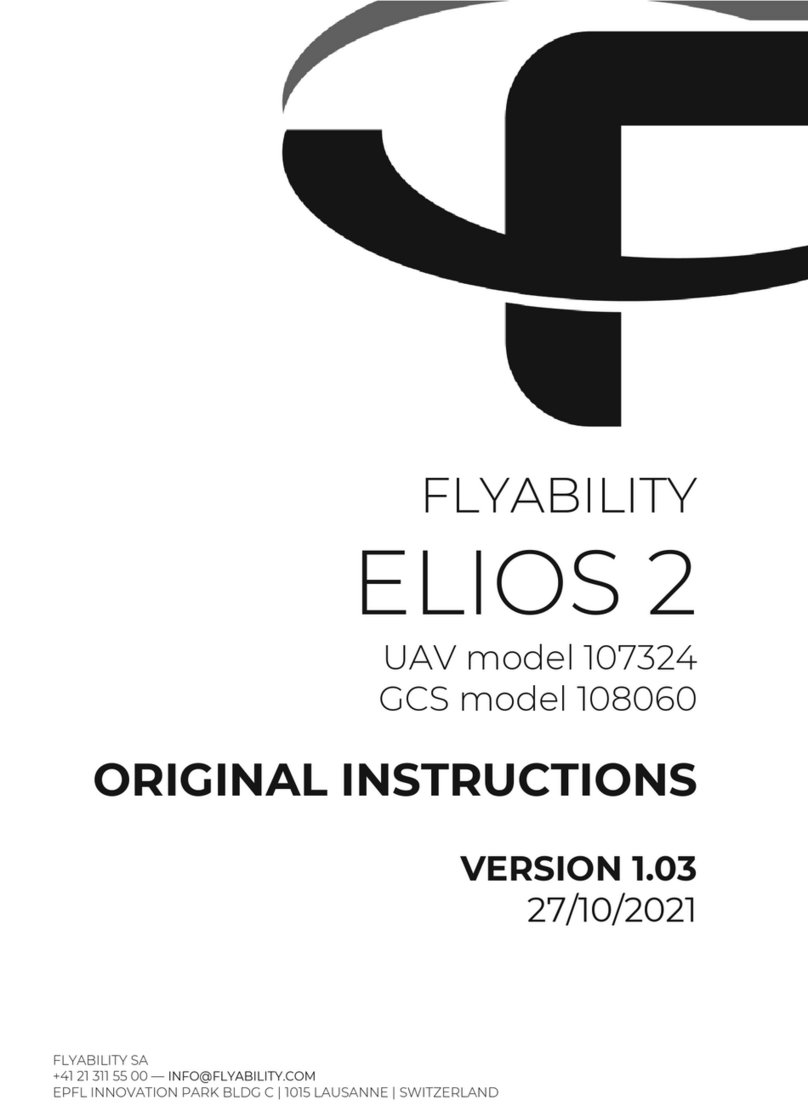
Flyability
Flyability ELIOS 2 UAV User manual
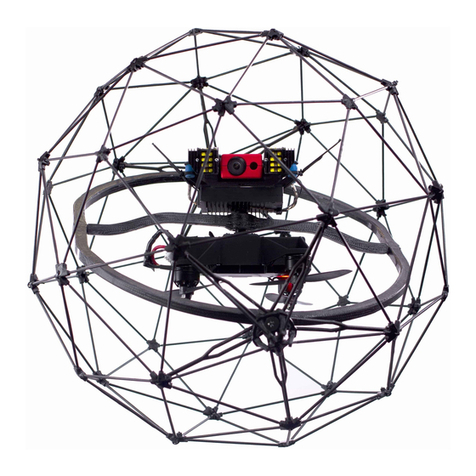
Flyability
Flyability ELIOS User manual

Flyability
Flyability ELIOS 1 User manual

Flyability
Flyability Elios 3 User manual
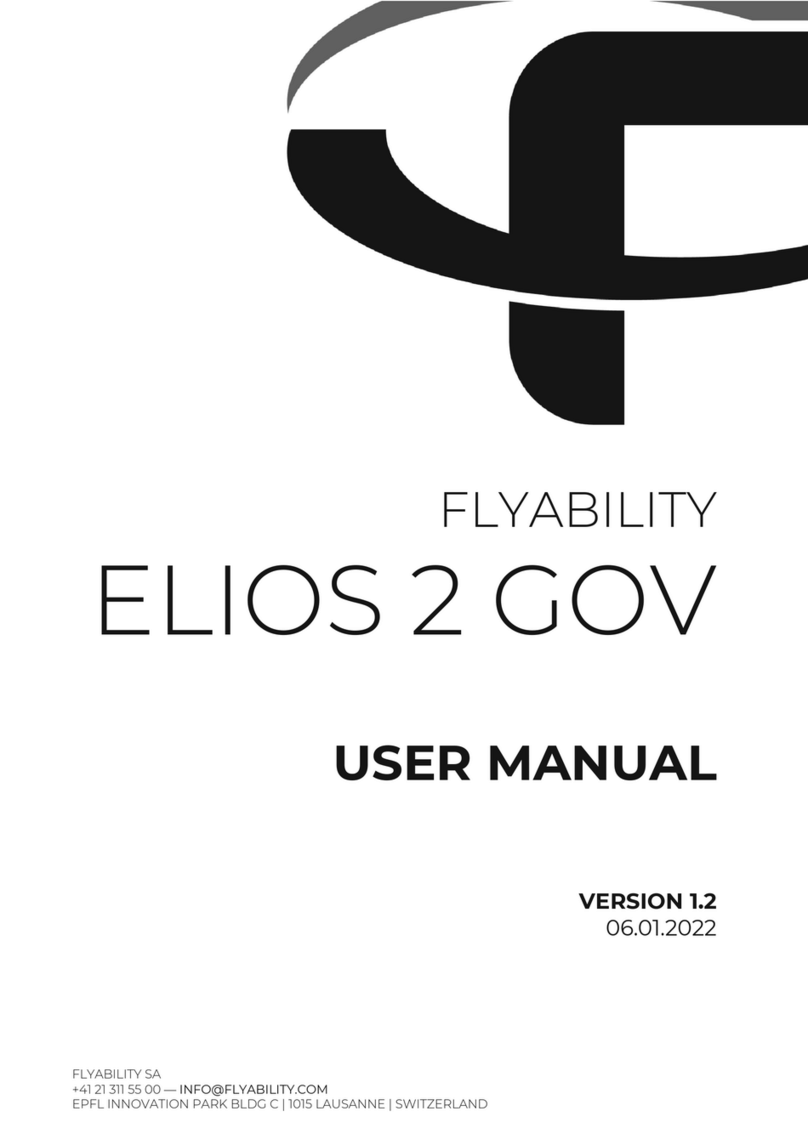
Flyability
Flyability ELIOS 2 GOV User manual
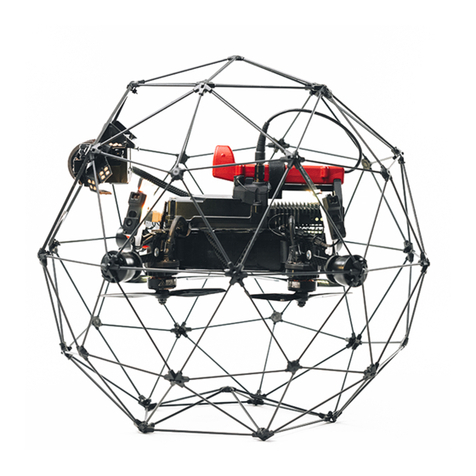
Flyability
Flyability ELIOS 2 RAD User manual
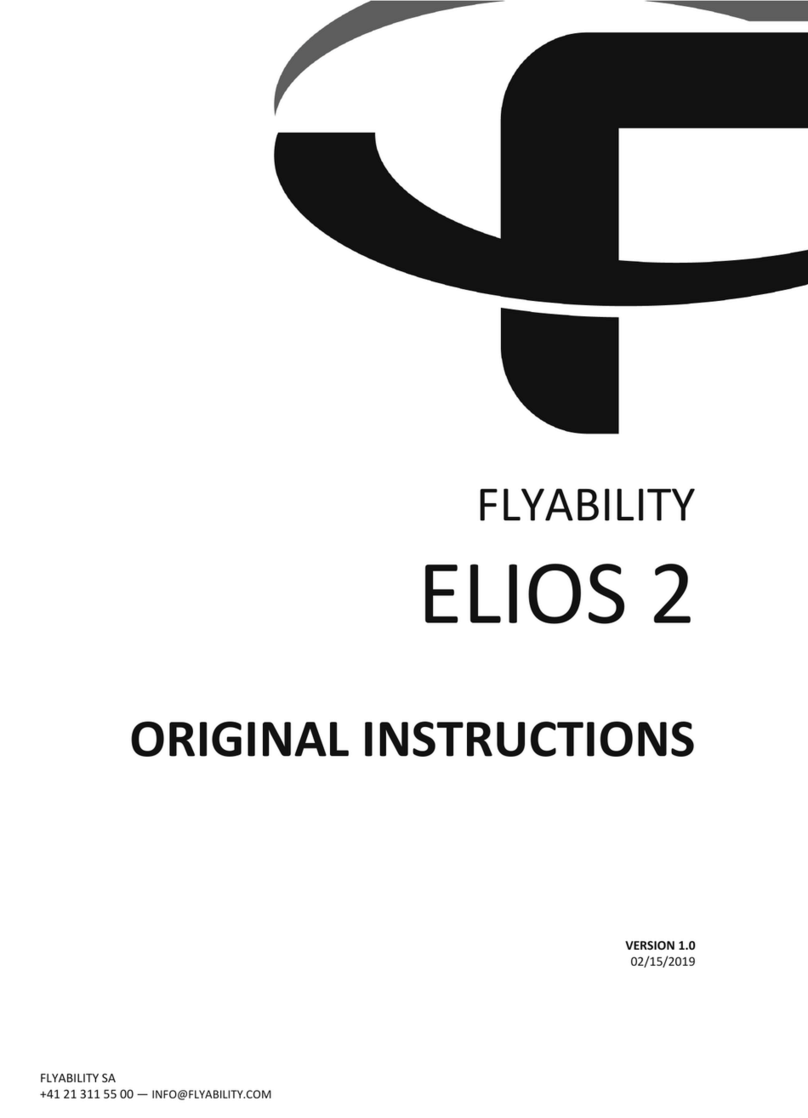
Flyability
Flyability ELIOS 2 User manual
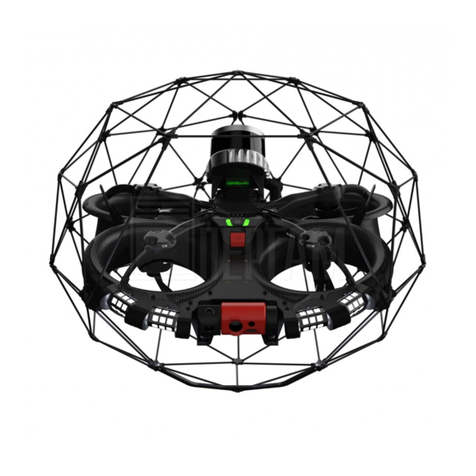
Flyability
Flyability Elios 3 User manual

